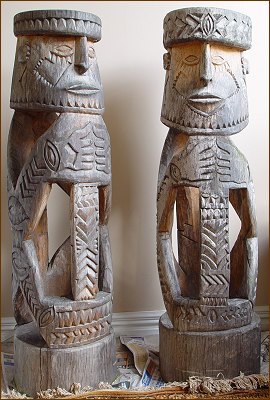“Carving is a big part of the tribe’s traditional culture.”
When the woodcarvers of Papua’s Kamoro tribe look at a piece of timber, they see more than just a block of wood. They see a potential work of art.
“When I see a piece of wood,  I always try to imagine what my wemame [statue] is going to look like,” said Vincent Maopeyauta.
I always try to imagine what my wemame [statue] is going to look like,” said Vincent Maopeyauta.
The 43-year-old and two of his fellow tribesmen, Leo Wawkateyaw and Yohanes Matameka, were in Jakarta for the opening of the Jakarta Kamoro Art Gallery in Menteng, Central Jakarta.
The three men are members of the semi-nomadic Kamoro tribe, which lives in a 200-kilometer stretch along the south coast of West Papua,  in the lowlands surrounding the snow-capped mountains and glaciers of the Jayawijaya range.
in the lowlands surrounding the snow-capped mountains and glaciers of the Jayawijaya range.
The entire tribe consists of around 18,000 people, spread out among villages of 2,000 to 5,000 residents. The Kamoro are hunters and gatherers who depend on the seashore, mangrove swamps and tropical rainforests for their livelihoods.
Carving, which most Kamoro boys learn at a very young age, is a big part of the tribe’s traditional culture.
“Without woodcarving, I wouldn’t know what to do with my life,” said 48-year-old Leo.
While he believes that the best woodcarvers are born, not made, Leo said he learned the craft from his father.
“If he’s good, a boy can make good wood pieces immediately, just by watching his elders,” said Leo as he put the final touches on a carving of a man and a cockatoo — a piece he completed in less than a day.
According to Kalman Muller, a Hungarian-born American who has lived with the Kamoro tribe for more than 15 years, woodcarving is an important aspect of the tribe’s culture, especially for men.
Muller said learning to create ceremonial sculptures out of wood was a symbol of initiation into adulthood for Kamoro boys. It help them transition from the world of femininity, where they are reliant on their mothers, to the adult world of maturity and responsibility.
Muller, who works for the mining giant Freeport Indonesia, is committed to helping the Kamoro people distribute and sell their artwork to a wider market so the tribesmen can earn some extra money.
Aside from the cash the carvings can generate for Kamoro communities, Muller said he hoped to encourage the carvers to be proud of their cultural heritage.
All Kamoro men are able to produce carvings of various sizes and functions. Almost all of their villages feature mbitoro totem poles, used for initiation ceremonies.  Other typical carvings include yamate shields, otekapa walking sticks and wemawe human figures, usually made to represent their ancestors.
Other typical carvings include yamate shields, otekapa walking sticks and wemawe human figures, usually made to represent their ancestors.
The tribesmen’s designs are mostly inspired by nature. In addition to humans, they often depict birds and crocodiles. Many of the carvings symbolically represent stories from Kamoro history and folklore.
One such piece on display at the Jakarta Kamoro Art Gallery is a yamate shield, created by Yohanes, which tells the story of the time when his village was appointed the capital city of Mimika district. The design consists of a chain, symbolizing Kamoro kinship, a bird flying with an eme drum in its beak and three human figures dancing by the village’s entrance gate to celebrate its connection to the outside world.
In the spirit of openness, Vincent, Leo and Yohanes shared some of the customs of their village with visitors at the gallery’s opening last week.
Dressed in sago-bark skirts and cassowary-feather headdresses and decorated with white chalk, the trio performed a traditional dance and demonstrated their carving skills.
Speaking at the event, Muller said woodcarving used to be an integral part of the traditional religion for the Kamoro people, but many of their indigenous beliefs and practices were lost due to the influence of the Catholic church.
Muller wants to help preserve the remaining practices of the tribe, not just by creating a market for their woodcraft, but also by encouraging formal education.
“At first, their woodcraft did not have good selling points,” Muller said, adding that it took some time to develop a market for the art.
Under his supervision, about 300 woodcarvers are now producing pieces designed to have broader appeal.
Even during their visit to Jakarta, the woodcarvers remained totally committed to their craft. Vincent said he never went a day without working on a sculpture.
Muller said most Kamoro people were content with their lives and were not interested in chasing “success” the way people do in big cities.
“Sure, you get jealous when your neighbor gets a TV a few inches bigger than yours, but that is not a big deal [for the Kamoro],” he said.
While outsiders may think the Kamoro live in poverty, Muller said members of the tribe themselves believe they live a good life. They appreciate family ties as an eternal bond that helps them throughout life. They define luxury as extra money to buy flashlights, batteries or fuel. Most of the time, they just eat the fish they catch and the fruits and vegetables they plant.
As for Leo and friends, they are happy enough to know their woodcarving skills are appreciated by the people who are buying their creations.
Source: Jakarta Globe
 the involvement of the Military Regional Command (Kodam) XVII/Cenderawasih in the literacy program in the hinterland of Papua.
the involvement of the Military Regional Command (Kodam) XVII/Cenderawasih in the literacy program in the hinterland of Papua.




